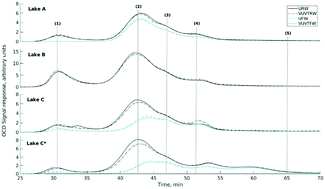当前位置:
X-MOL 学术
›
Environ. Sci.: Water Res. Technol.
›
论文详情
Our official English website, www.x-mol.net, welcomes your feedback! (Note: you will need to create a separate account there.)
Impact of vacuum UV on natural and algal organic matter from cyanobacterial impacted waters
Environmental Science: Water Research & Technology ( IF 5 ) Pub Date : 2020/01/22 , DOI: 10.1039/c9ew01068h Flavia Visentin 1, 2, 3, 4, 5 , Siddharth Bhartia 6, 7, 8, 9 , Madjid Mohseni 6, 7, 8, 9 , Sigrid Peldszus 9, 10, 11 , Sarah Dorner 1, 2, 3, 4, 5 , Benoit Barbeau 1, 2, 3, 4, 5
Environmental Science: Water Research & Technology ( IF 5 ) Pub Date : 2020/01/22 , DOI: 10.1039/c9ew01068h Flavia Visentin 1, 2, 3, 4, 5 , Siddharth Bhartia 6, 7, 8, 9 , Madjid Mohseni 6, 7, 8, 9 , Sigrid Peldszus 9, 10, 11 , Sarah Dorner 1, 2, 3, 4, 5 , Benoit Barbeau 1, 2, 3, 4, 5
Affiliation

|
Cyanobacterial blooms are a growing concern around the world. A feasible approach for small treatment plants fed by sources contaminated with cyanobacteria is vacuum UV (VUV). VUV is a promising advanced oxidation process used to treat water impacted by cyanobacterial blooms, with potential applicability in small and remote communities because of its simplicity. In this work, water samples from three Canadian lakes periodically affected by cyanobacteria were used to assess the impact of natural and algal organic matter (NOM/AOM) on treatment with VUV. NOM and AOM were characterized before and after VUV treatment by size exclusion chromatography (SEC) and fluorescence emission–excitation matrix (FEEM). FEEM spectra were analyzed with the parallel factor analysis (PARAFAC) tool. As a result, we found seven principal components describing the whole dataset. Disinfection by-product (DBP) formation after VUV treatment was analyzed and trihalomethanes (THM) yield was calculated. THM yield increased by 15–20% after VUV treatment. Regarding DBP formation and NOM/AOM fractions from SEC, we found that humic substances are the most important fraction causing the increase in DBP formation with at least 3 times higher yield than the other fractions: biopolymers, building blocks, low weight molecular acids and neutrals.
中文翻译:

真空紫外线对受到蓝细菌影响的水中的天然和藻类有机物的影响
蓝藻水华在全世界引起越来越多的关注。对于由蓝细菌污染的源喂养的小型污水处理厂,可行的方法是真空紫外线(VUV)。VUV是一种很有前途的先进氧化工艺,用于处理受蓝藻水华影响的水,由于其简单性,在潜在的小型和偏远社区中具有潜在的适用性。在这项工作中,使用了三个加拿大蓝藻定期受到蓝细菌影响的水样,以评估天然和藻类有机物(NOM / AOM)对VUV处理的影响。在VUV处理之前和之后,通过尺寸排阻色谱(SEC)和荧光发射-激发矩阵(FEEM)对NOM和AOM进行了表征。用并行因子分析(PARAFAC)工具分析FEEM光谱。结果是,我们发现了描述整个数据集的七个主要成分。分析了VUV处理后消毒副产物(DBP)的形成,并计算了三卤甲烷(THM)的产率。VUV处理后,THM产量提高了15–20%。关于SEC的DBP形成和NOM / AOM组分,我们发现腐殖质是导致DBP形成增加的最重要组分,其收率至少是其他组分的3倍:生物聚合物,结构单元,低分子量分子酸和中性。
更新日期:2020-03-05
中文翻译:

真空紫外线对受到蓝细菌影响的水中的天然和藻类有机物的影响
蓝藻水华在全世界引起越来越多的关注。对于由蓝细菌污染的源喂养的小型污水处理厂,可行的方法是真空紫外线(VUV)。VUV是一种很有前途的先进氧化工艺,用于处理受蓝藻水华影响的水,由于其简单性,在潜在的小型和偏远社区中具有潜在的适用性。在这项工作中,使用了三个加拿大蓝藻定期受到蓝细菌影响的水样,以评估天然和藻类有机物(NOM / AOM)对VUV处理的影响。在VUV处理之前和之后,通过尺寸排阻色谱(SEC)和荧光发射-激发矩阵(FEEM)对NOM和AOM进行了表征。用并行因子分析(PARAFAC)工具分析FEEM光谱。结果是,我们发现了描述整个数据集的七个主要成分。分析了VUV处理后消毒副产物(DBP)的形成,并计算了三卤甲烷(THM)的产率。VUV处理后,THM产量提高了15–20%。关于SEC的DBP形成和NOM / AOM组分,我们发现腐殖质是导致DBP形成增加的最重要组分,其收率至少是其他组分的3倍:生物聚合物,结构单元,低分子量分子酸和中性。


























 京公网安备 11010802027423号
京公网安备 11010802027423号